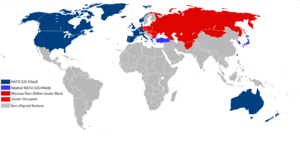العاصفة الحمراء تهب
 Cover of 1986 first edition | |
| المؤلف | Tom Clancy |
|---|---|
| البلد | United States |
| اللغة | English |
| الصنف | Techno-thriller, war novel |
| الناشر | Putnam Publishing |
تاريخ النشر | August 1986 |
| نوع الوسائط | Print (hardback & paperback) |
| الصفحات | 656 p. (hardback edition) |
| ISBN | 0-399-13149-3 (hardback edition) |
| OCLC | 13475110 |
| 813/.54 19 | |
| تب. مك.كونگ | PS3553.L245 R4 1986 |
Red Storm Rising is a 1986 technothriller novel by Tom Clancy about a Third World War in Europe between the North Atlantic Treaty Organization (NATO) and Warsaw Pact forces, set around the mid-1980s. Though other novels deal with a fictional World War III, this one is notable for the way in which numerous settings for the action—from Atlantic convoy duty to shooting down reconnaissance satellites to tank battles in Germany—all have an integral part to play on the outcome. It was also unusual in its depiction of a World War III fought exclusively with conventional weapons, rather than escalating to nuclear warfare.
It is one of three Clancy novels (with SSN and Against All Enemies) not associated with the Jack Ryan universe.
The novel eventually lent its name to a game development company called Red Storm Entertainment, which Clancy co-founded in 1997.
. . . . . . . . . . . . . . . . . . . . . . . . . . . . . . . . . . . . . . . . . . . . . . . . . . . . . . . . . . . . . . . . . . . . . . . . . . . . . . . . . . . . . . . . . . . . . . . . . . . . . . . . . . . . . . . . . . . . . . . . . . . . . . . . . . . . . . . . . . . . . . . . . . . . . . . . . . . . . . . . . . . . . . . .
ملخص الحبكة
Islamic terrorists from Azerbaijan destroy a Soviet oil-production facility at Nizhnevartovsk, Russia, crippling the USSR's oil production and threatening to wreck the nation's economy. Contemplating concessions to the West to survive the crisis, the Politburo instead decides to seize the oil fields in the Persian Gulf by military force.
According to the Carter Doctrine, any attack on the Gulf is an attack on strategic interests to the United States, necessitating a military response. To prevent a combined reaction by NATO, the Soviets launch a KGB operation to carry out a false flag operation framing West Germany for an unprovoked attack on the USSR; afterwards, the Soviets plan to invade Western Europe in response to that “attack”. With West Germany occupied, and NATO defeated, the Soviets hope that the U.S. will not rescue the Arab oil states when it attacks them, as it can meet its oil needs with Western sources. The Politburo arranges a bomb blast in the Kremlin that kills some visiting schoolchildren, blaming a West German exile for the attack.
The KGB operation has limited success: the planned attack on West Germany is detected when a Spetsnaz infiltrator, Soviet-Afghan War veteran Major Andrei Illych Chernyavin, happens to be hit by a car in Aachen, is found to be carrying incriminating documents, and is questioned under narcoanalysis. This advance knowledge gives NATO time to mobilize its forces, destroy numerous Spetznaz direct action strike groups, and preserve the alliance. Mention is made of a completely successful Spetznaz sabotage mission against the Kiel Canal. The Soviet advance operations do achieve some success, since several governments—notably those of Greece and Japan—publicly claim that this “German-Russian dispute” does not warrant outside involvement. The Soviets face no opposition in either the Pacific theater or the Mediterranean region.
NATO aircraft manage to sharply reduce Soviet ground superiority on the first night of the war by using first-generation stealth planes and tactical fighter-bombers to eliminate Soviet Mainstay airborne early warning aircraft and tactical fighters. The NATO forces achieve air superiority and destroy many key bridges over which much of the Soviet Army had yet to cross. Soviet strategic assumptions have been severely skewed by politically motivated best-case projections from the KGB, and this has lulled their logisticians to fail to give sufficient attention to NATO's defensive firepower. Warsaw Pact forces advance at a tremendous cost. Germany becomes the epicentre of the conflict; here, NATO forces are slowly driven west while inflicting significant damage to the encroaching Soviet Army.
Simultaneously, the Soviets seize Iceland in a covert surprise attack with the Soviet merchant ship Julius Fucik disguised as a Lykes Lines American LASH ship, capturing the NATO air station at Keflavík and eliminating the GIUK-SOSUS line to allow the Soviet Navy to surge its submarines into the Atlantic Ocean without being detected. In addition, the Soviet Navy takes steps to protect its ballistic missile submarine fleet in coastal waters behind minefields and ASW assets, freeing up its attack submarines to engage and destroy NATO shipping. Thus, the Soviet Navy is able to act as an offensive weapon contrary to prewar NATO expectations, becoming a major strategic threat against resupply convoys coming from North America with both aircraft and submarines. This advantage is put to immediate use as a NATO carrier battle group, led by يوإسإس Nimitz, USS Saratoga and the French carrier Foch, is successfully attacked by Soviet Badger and Backfire bombers, the latter firing Kingfish missiles. عندها، يطلق سلاح الجّوّ السوفياتي خطّته التي تدرّب عليها لسنوات، ويستلزم تنفيذها قدرات إمبراطوريّة. مئة قاذفة توبوليف ـــ 16 «بادجر» ضخمة، خلفها سبعون قاذفة توبوليف ـــ 22 «باكفاير» حديثة أسرع من الصّوت، وبينهما عشر قاذفات توبوليف ـــ 95 «الدّبّ»، متخصّصة بالتشويش الرّاداري. حين تقترب الموجة الأولى من القاذفات من مدى الرّادار للأسطول الأميركي، تفلت من تحت أجنحتها مئتان من صواريخ الـ«كيلت» الجوّالة باتّجاه العدوّ، وتستدير عائدة. تلاحق طائرات الحرب الإلكترونية الصّواريخ العشرة المحلّقة، خالقة خلفها جداراً من التشويش عرضه 800 كيلومتر. وخلف ذاك الجدار الإلكتروني تختبئ قاذفات «باكفاير». الصّواريخ الجوّالة قديمة وغير مصمّمة لمواجهة السّفن، غير أنّها بُرمجت لتطير على ارتفاع عالٍ وبشكل يحاكي طيران أسراب القاذفات. حين تلتقط القيادة الأميركيّة الأهداف العديدة على الرادار، تستنتج أنّها موجةٌ من القاذفات الرّوسيّة تحاول قصف الأسطول، فترسل باتّجاهها طائراتها المعترضة، التي ستستنفد صواريخها في إسقاط أهدافٍ لا قيمة لها، من خلف مدى النّظر، وباستعمال الرّادار. ما إن تختفي موجة صواريخ «كيلت» عن الرّادارات الأميركيّة حتّى يظهر، من خلف جدار التّشويش الّذي كُشف، مئة وخمسون صاروخاً مضادّاً للسّفن، أطلقتها قاذفات «باكفاير» التي تلوذ الآن بالفرار. تمسح الصواريخ متسارعة سطح الماء باتّجاه الأسطول الذي صار أعزل إلّا من وسائط دفاعه الذاتيّة، وبعدها بلحظات، يشتعل المحيط. تختفي الحاملة الفرنسيّة «فوش» في أعماق البحر، ومعها العديد من المدمّرات والسّفن، وتصاب الحاملة الأميركيّة بصاروخ، لكنّ السفينة العملاقة تترنّح ولا تغرق.
Legacy
In December 2015, a document released by the UK National Archives revealed that, shortly after the October 1986 Reykjavík Summit between Soviet General Secretary Mikhail Gorbachev and U.S. President Ronald Reagan, the latter had advised UK Prime Minister Margaret Thatcher to read the novel in order to gain an understanding of the Soviet Union's intentions and strategy.[1]
See also
== المراجع ==
وصلات خارجية
- Pages to import images to Wikidata
- روايات أمريكية في 1986
- روايات تشويق أمريكية
- Techno-thriller novels
- روايات حرب أمريكية
- روايات الحرب الباردة
- Origins Award winners
- روايات عن قتال الغواصات
- روايات عن الارهاب
- روايات توم كلانسي
- World War III speculative fiction
- روايات حرب عن الاتحاد السوڤيتي
- Space warfare in fiction
- أعمال عن البحرية الأمريكية
- فيالق مشاة البحرية الأمريكية في الثقافة الشعبية
- عسكرية الولايات المتحدة في الخيال
